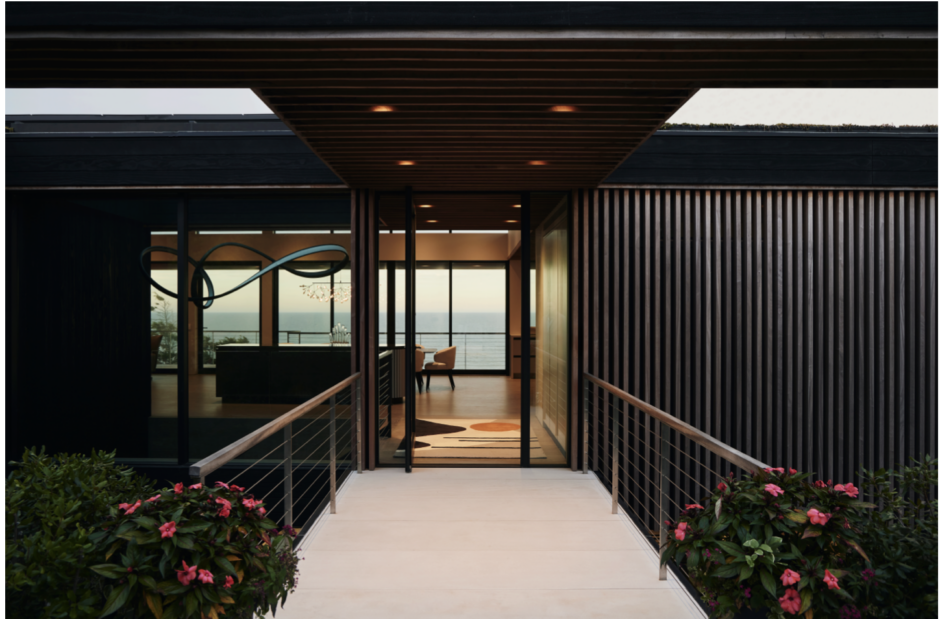
2024 Architecture Merit Award
OCEAN BLUFF
Michael Lomont, Stelle Lomont Rouhani Architects
——————————–
across the dunes to the ocean below.


www.stelleco.com
———————————————-

2024 Architecture Merit Award
Springy Banks
Viola Rouhani AIA, Stelle Lomont Rouhani Architects
The east end of Long Island is a land of layered histories, and the area known as Three Mile Harbor is no exception. The waterfront properties surrounding the harbor once supported generations of farmers who shipped salt hay to Connecticut. Prohibition era rumrunners, boaters, and more recently boating pleasure seekers have all been documented on its shores. Before any settlers came along, this land belonged to the Native Americans, whose remnants of arrowheads are still being catalogued today. It’s an ongoing careful study that dictates where we can and cannot build. When we were first approached to explore the possibilities of one of the perhaps more notorious properties along the shore, the property known as the former Duke Estate, our first thoughts went to these histories, and the land that afforded them.
Mr. Duke was well known for his charitable contributions. He created the Boys and Girls harbor, a camp for underprivileged city youth to come and be one with nature, next to the property where he once lived himself. The trails and rugged outdoor area that once housed the camp has since been purchased by the Town of East Hampton and Suffolk County, preserved for recreational use by the public. The Duke property itself saw change after the original house burned down, and another, not particularly sensitive to the site was put in its place. Our initial involvement was to try to make sense of the site, made up of three separate properties, in collaboration with the Landscape architects. Thoughts were initially floated to try and preserve the house that sat at the very end of a long straight driveway. The house blocked the view of the water and made for an awkward space between it and the bluff, which dropped steeply off into the shore.
We decided that saving the house in its current location, with its disregard to the history and the potential for celebrating the landscape the way it deserved to be, was not a road we were interested in taking. We respectfully recused ourselves from the project happy to be at the owners’ disposal should they change their mind about how to approach the property. It was not long before we got the call to please go ahead and work with the Landscape team to reimagine the site the way we thought would do it justice. Our first step was to work on remediation of the waterfront, and to think of how best to address the three properties that made up the project. We knew we wanted a new house to pull away from the water, to allow land and space between the two, both as a rehabilitation measure, and out of respect for both.
We also wanted the experience of the land to begin at the street in a way that would clearly start the story right out of the gate so to speak. This was a clear departure from the existing straight driveway that took the trees for granted. A carefully crafted driving path, weaving its way through the original indigenous and supplemented native landscape allows for a full appreciation of the forest. We were careful to site the house in such a way that the approach would foremost allow for the view of the water ahead before having any structure come into play. The house itself is a low-slung affair, clad in grey stained wood siding, to help it along with its weathering, the goal being to have it recede and blend completely with the landscape over time. The notion of the camp figured large as well. Instead of over building the three properties, each is given a specific program with room to breathe. The largest holds the house, nestled into the natural topography, with its view of the bluff. It is separated with a continuation of the forest landscape from a tennis court, that is all but hidden from view at the initial approach. Another of the properties holds a simple wood enclosure, with a covered porch. It’s a pool house that offers shelter by the pool, which has a clear view of the water as well, quite pulled away though to allow the space and distance for contemplation. The third property is mainly left untouched but for a vegetable garden. This site is hillier and forested and becomes a destination. Paths join the various structures.
The house itself is long and low. The main floor is the ground floor, and it has a direct connection to the ground. The restored bluff and the water are to the north and views of same are accessed across the length of the house. An open porch, with hideaway screens to the east, offer the indoor-outdoor element so often sought, above it a roof deck for further vistas both of water and trees. The southside is open to a created garden, rife with flowering cherry trees, it’s the only constructed seeming landscape on the premises. Floor to ceiling wood framed glass covered by a continuous overhang to protect the house allows for the feeling of living on a big porch. As the grade falls off to the west, the lower story with its bedrooms and recreational spaces benefits from the light and access on this level as well.
The interiors of the house carry the warmth of wood inside. Walls are painted a muted white and become the backdrops to art, both physical art and the beautify of the surroundings. Each solar direction is framed and captures a unique appreciation of the land both in its present and past incarnations.

~~~~~~~~~~~~~~~~~~~~~~~~~~~~~~~~

—————-
www.stelleco.com
______________________________________________________
